Reykjanes Peninsula is the youngest part of Iceland, formed when lava flowed out into the ocean and solidified to form a new land. It is home to Iceland’s international airport, Keflavik, which is often referred to as Reykjavik Airport. This is misleading as Keflavik is a good 45 minutes drive away from the capital city Reykjavik. But I digress.
As there was just the two of us, we didn’t want to rent a car and drive in unfamiliar territory. Hence, we signed up for a day tour with IG Tours at ISK 11900/pax. This includes driving to the Blue Lagoon but excludes the entrance ticket, which would set one back at an equivalent of 35 euros/pax.
At 8.30am when the sun had barely risen, we waited at the front door of our hostel where the tour would pick us up from, hugging our jackets tightly to our bodies and shivering in the strong winds. The temperature was already hovering at around five degrees Celcius despite it being end October. A big tour bus rolled up at the entrance and we thought that it was our bus. However, it turned out to be for a different IC tour to the Golden Circle. When we gave our names, the driver made a brief call before asking us if we could shift our Reykjanes tour to tomorrow and take the Golden Circle tour today. This arrangement was impossible because we had already signed up for a Golden Circle tour the next day with a different tour company. Eventually, the bus left after picking up its passengers.
A white 4×4 jeep pulled up in front of our hostel at 9am sharp. Initially, I was incredulous that this would be our ride for the day, but it turned out that we were the only two people booked for that day, so instead of dispatching a tour bus or even minivan, the driver cum guide came in a jeep instead. In effect, it was a private tour for the price of a group tour! No wonder they tried to get us to join another tour instead.
The driver drove us to a harbour just outside Reykjavik, where we stopped for a toilet break as the next attraction would be in a remote area without any sanitary facilities. We then drove for about an hour before we spotted a random structure where fish were hung from it, drying. The driver stopped for a moment so that we could hop out and explore the place. That is the beauty of private tours – we had the freedom to stop anytime, linger or move on.
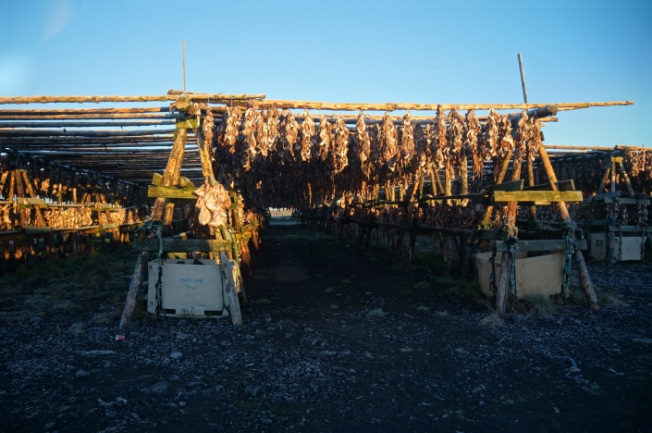
The main attraction throughout the drive was really the jaw-dropping scenery outside. It was my first time, here in Iceland, that I could really feel the absolute isolation from the world. We could drive on for hours and not see anybody within a 10 or even a 100 kilometre radius. It was ourselves and the stark landscape. It was a truly surreal feeling to behold.
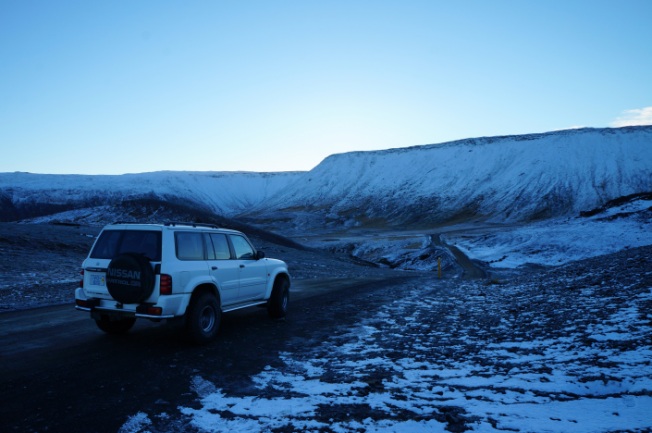
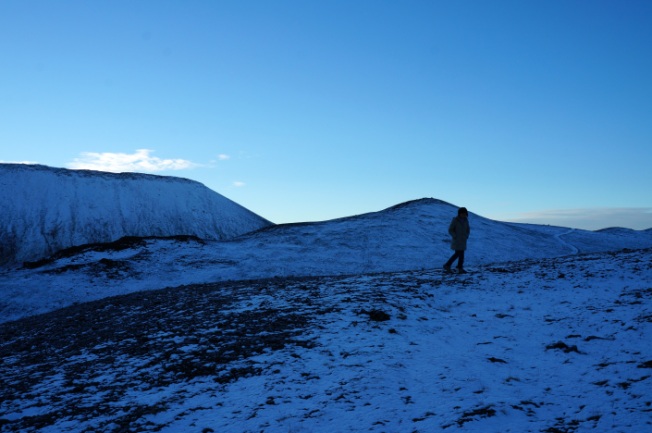
As I sat in the car and looked out of the window, it felt like I was the host of a National Geographic documentary, here to film the great nature. Every piece of scenery, however random, was breathtaking and postcard-perfect. Iceland is indeed a photographer’s haven. The rare clear blue skies that day also helped tremendously. Absolutely lovely weather!
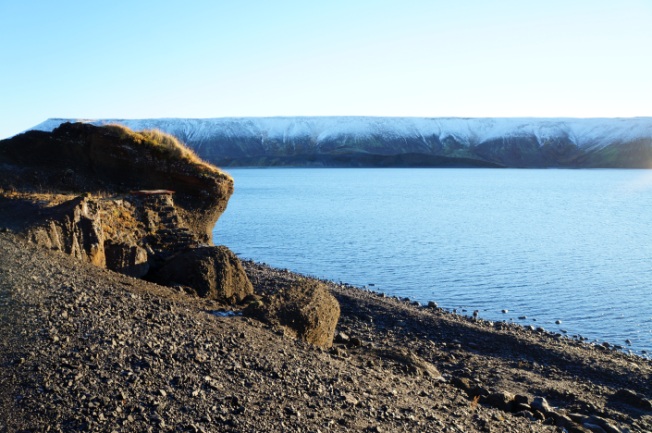
As mentioned earlier, Reykjanes Peninsula is the newest part of Iceland, thus the lack of substantial vegetation. It mostly consisted of dark basaltic rocks and sand. One could almost imagine touring the Moon itself.
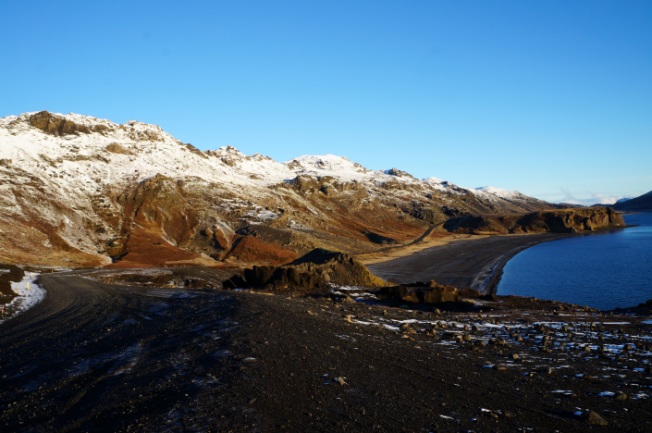
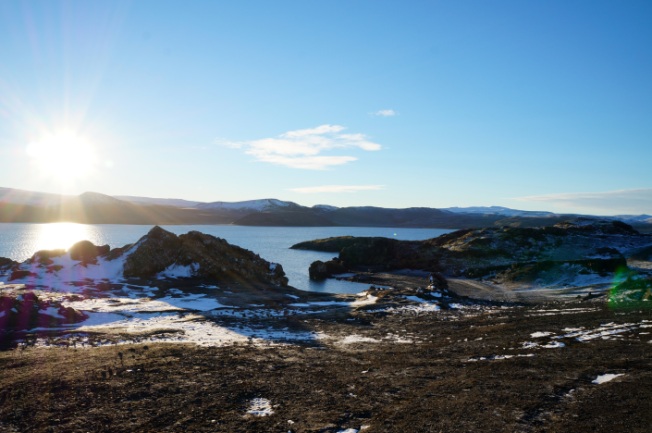
While in the car, I spotted a herd of Icelandic horses grazing and quickly snapped a photo. It was only later that I realised the horse in the extreme left of the photo looked uncannily like a cow.
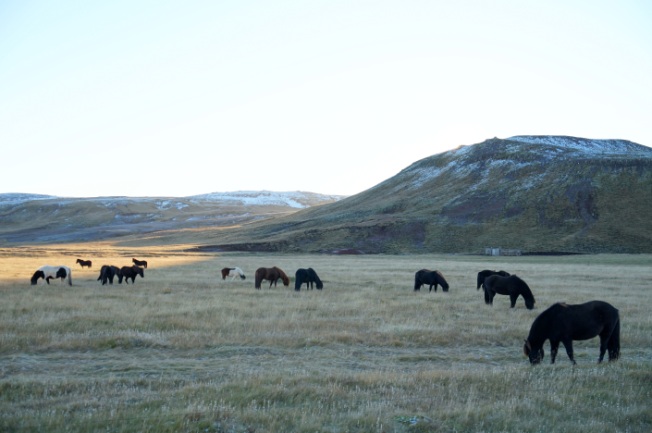
Another stop at a lava field. The driver pointed out the orange pole to us and revealed that it demarcated an important trading route used by the Vikings (I think), the ancient settlers, in the past. Because Iceland suffered from frequent volcano eruptions, the path would be regularly covered in a fresh coat of lava and required some time before the solidified lava could be cleared. Therefore, the pole delineated the path and prevented people from getting lost.
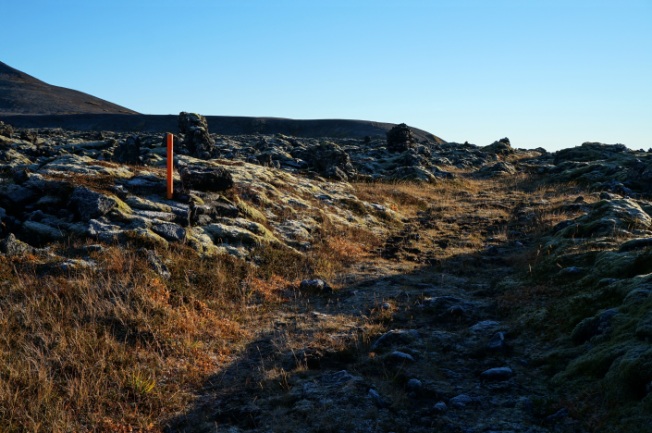
We next stopped at a shipwreck in the midst of another lava field. Shipwrecks were a fact of life in Reykjanes’ treacherous coast. This is just one of the many shipwrecks in the area.
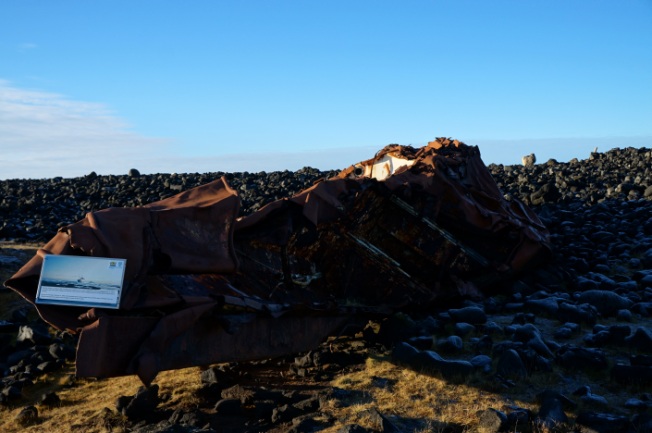
My friend noticed that there were two sheep standing at the top of a small mount near the wreckage, unmoving. They were so still that I almost thought they were statues. After I snapped a photo and lowered my camera, they moved off. Hmm.
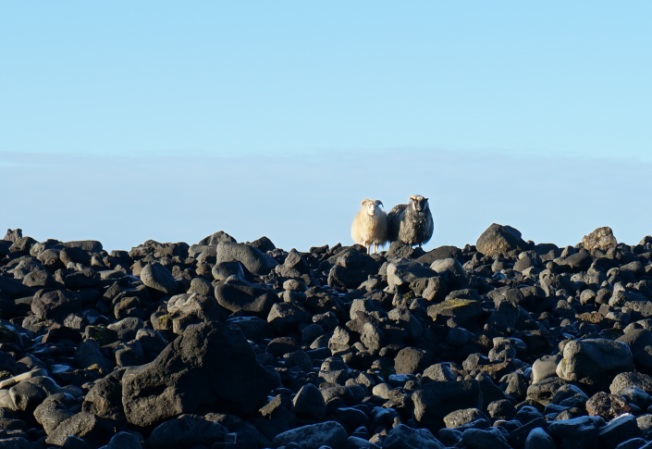
Iceland, being a volcanic island borne from the rare occurrence of a hotspot lying between two diverging tectonic plates, is bursting at the seams with geothermal energy and many geothermal plants exist to harvest this energy. The driver drove us to one such plant where steam was gushing out from small holes in the ground, misting up the place. This steam is hot though, so do not stand directly at the openings as you might scald yourself.
The smell of sulfur is also pretty strong. Do not mistake it as the smell of rotten eggs or worse still, your travel companion(s)’ flatulence, although it smells very similar to that!
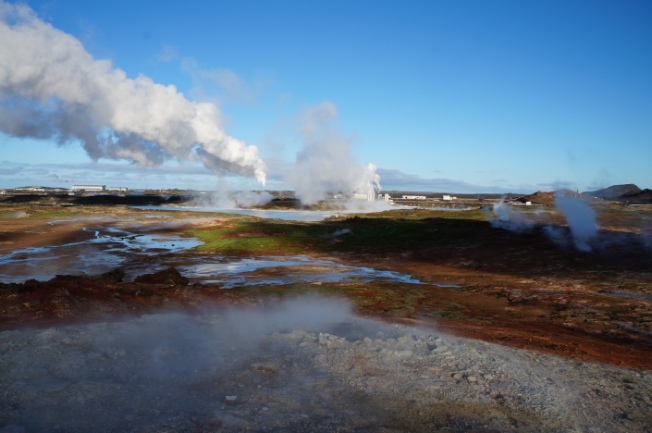
The next stop was a cliff with an amazing view of the jagged coastline of Iceland, facing the Atlantic ocean.
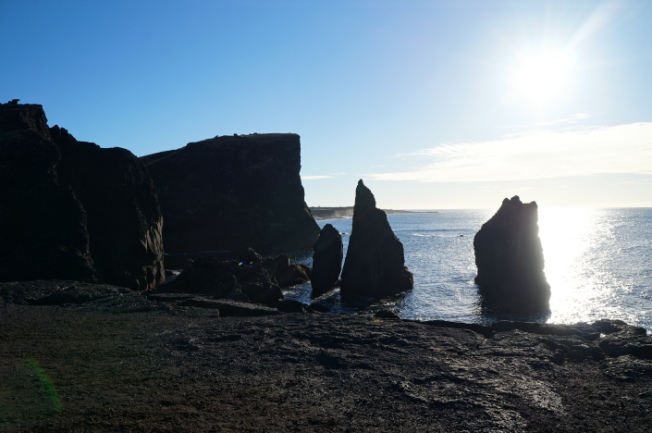
The driver took us to a place which lies directly over the mid-Atlantic ridge. This is the site where the North American and Eurasian plates are diverging and this effect created a small rift valley overland. A wooden bridge joins the two plates and right in the middle of the bridge lies a sign with a cheesy slogan – “in the footsteps of the gods”. Basically it is supposed to represent crossing over from Europe to America, although if one wants to be pedantic about political boundaries, this isn’t really the case.
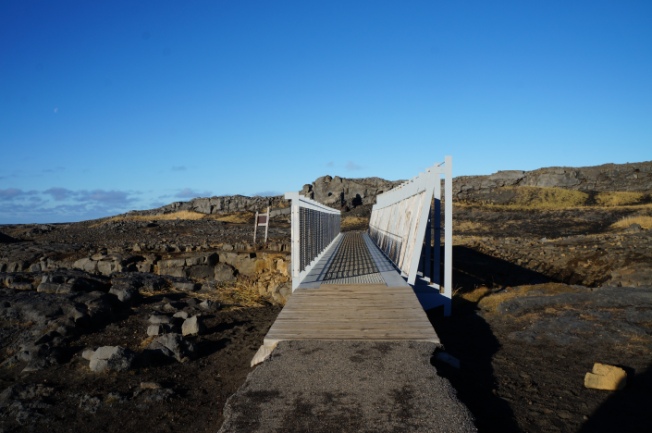
Crossing midway along the bridge, I could get a clearer picture of what the plate boundary actually looked like. During Geography lessons, I had the unrealistic expectation that lava would be oozing out from between the plates (since we learnt about the spreading sea floor at the mid-Atlantic ridge), but of course it would be impossible to see it overland since Iceland is a huge pile-up of solidified lava which rose above sea level.
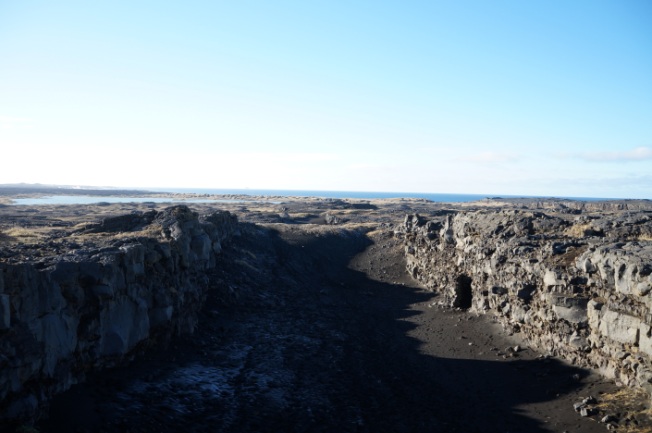
There is a much nicer representation of the mid-Atlantic ridge in Thingvellir, which is part of the Golden Circle route, but this one is a pretty interesting site as well.
We then proceeded to a museum which depicted the history of the Vikings and their arrival and settlement in Iceland. As I’m a scenery buff, this museum was a bit of a bore but it is kind of educational.
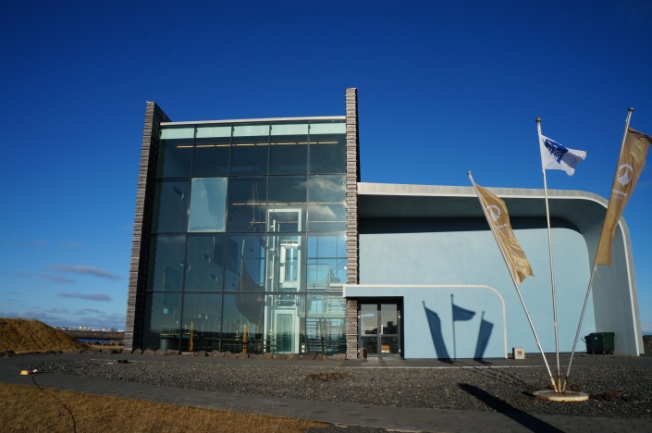
Finally, we proceeded to our final stop of the day – the Blue Lagoon! Entrance fee isn’t included in the tour price. One could choose to either pay in Icelandic kronas (ISK5600) or in euros (€35). The exchange rate is more or less similar, so if you know that you will have excess kronas, you might as well pay in kronas as some money would be lost when converting unused kronas back to euros or any other currency.
The Blue Lagoon is not a natural phenomenon. It is actually a by-product of the nearby geothermal plant, where the water output is channeled into an area to be disposed of. Initially water collected there like just any junkyard, but some astute businessman realised the potential of this as a tourist trap attraction, thus he converted it into the Blue Lagoon for people to soak in!
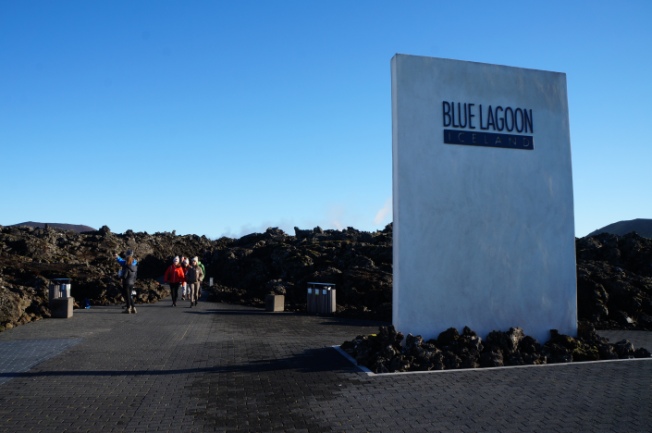
The lagoon is indeed a lovely place, with the warm water being a curious milky blue. It is such a luxury to be able to soak in the warm water (approx 40 deg Celcius) with the cool air hanging above you, though it does take some courage to be able to walk out into zero degree Celcius wearing just a swimsuit! The Blue Lagoon is reputed to have medicinal properties as well. The whitish silica mud that lines the bottom of the lagoon is said to have an exfoliating effect on your skin, thus making it soft and smooth. Don’t be in a hurry to grab some mud from the bottom, as there are boxes filled with clean mud lining the banks of the lagoon, where anyone can take for free to apply on themselves.
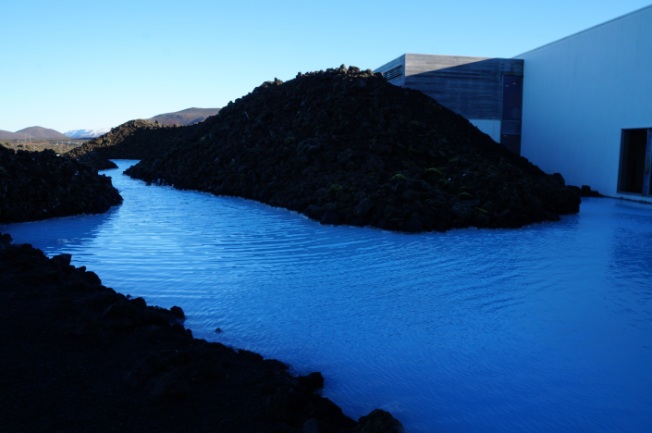
There are many other facilities at the Lagoon, such as a sauna and drinks. The drinks are not free but you can easily tap your waterproof bracelet (given to every patron of the Lagoon) to buy them. When you check out, whatever is recorded in the bracelet will have to be paid in cash. At one corner of the Lagoon, warm water cascades down into the pool like a waterfall. One can stand beneath that waterfall to have a non-electrical massage on their shoulders.
Tips for visiting the Blue Lagoon
One can easily spend about 2 hours relaxing at the Blue Lagoon. If you are cheapskate (like me), remember to bring your own towel to dry yourself off, as towels are not provided for free. There is a locker room where you can keep your belongings. Beside the locker room is a shower room where people are supposed to bathe before entering the lagoon. It is basic etiquette to do so. Bring your towel along with you up to the point where the lagoon is and hang it up at the designated area, as the cleaners are very strict and won’t allow people to re-enter the shower room dripping wet from the lagoon.
If you are a lady, bring a hairband and bundle up your hair before you enter the water. The water at the Blue Lagoon is highly detrimental to hair and will turn your hair to the consistency of hay within minutes. When showering after getting out of the water, slap loads of the provided conditioner onto your hair to repair some of the damage done.
Finally, as tourists, we all want something to remember this eventful trip to the Blue Lagoon by, so it is best to have waterproofing for your cameras or phones in case the said products decide to join you in the water. Alternatively like me, you could also rush back to the locker room halfway through to retrieve your camera and take some photos/selfies of your group, but this is troublesome because you have to stand outside in the cold and the camera is still subject to danger of being dropped into the water.
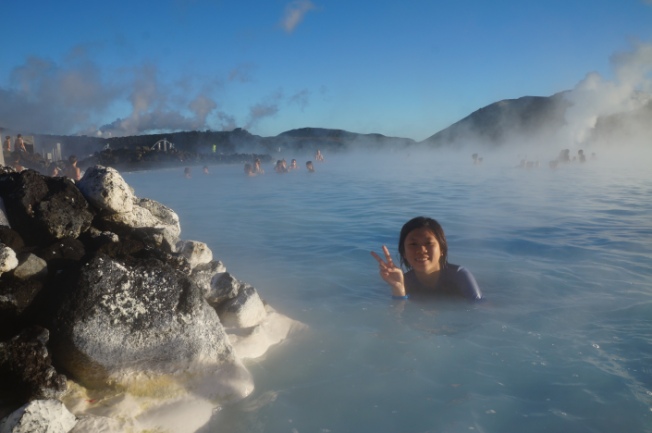
Honestly, the Blue Lagoon is rather overrated, as there are certainly nicer and cheaper hot spring options elsewhere in the world, such as Japan, which I am a mad fan of. However, this is Iceland and how often does one get to soak in a hot spring formed as a result of being a by-product of a geothermal plant? Not frequently, that’s for sure. It is totally geared towards tourists, but we are tourists so the Blue Lagoon is definitely worth a try. 🙂
We ended our second day in Iceland with a bang – the Northern Lights! Lady Luck took sympathy on us after the first unsuccessful night and gave us front row seats to the greatest show on earth. This will be covered in another post!

1 Comment
[…] that the tour was on! This wasn’t surprising given that the day that we had spent touring Reykjanes Peninsula had been totally cloud-free. Excitement begin to churn within me and it refused to be dampened by […]